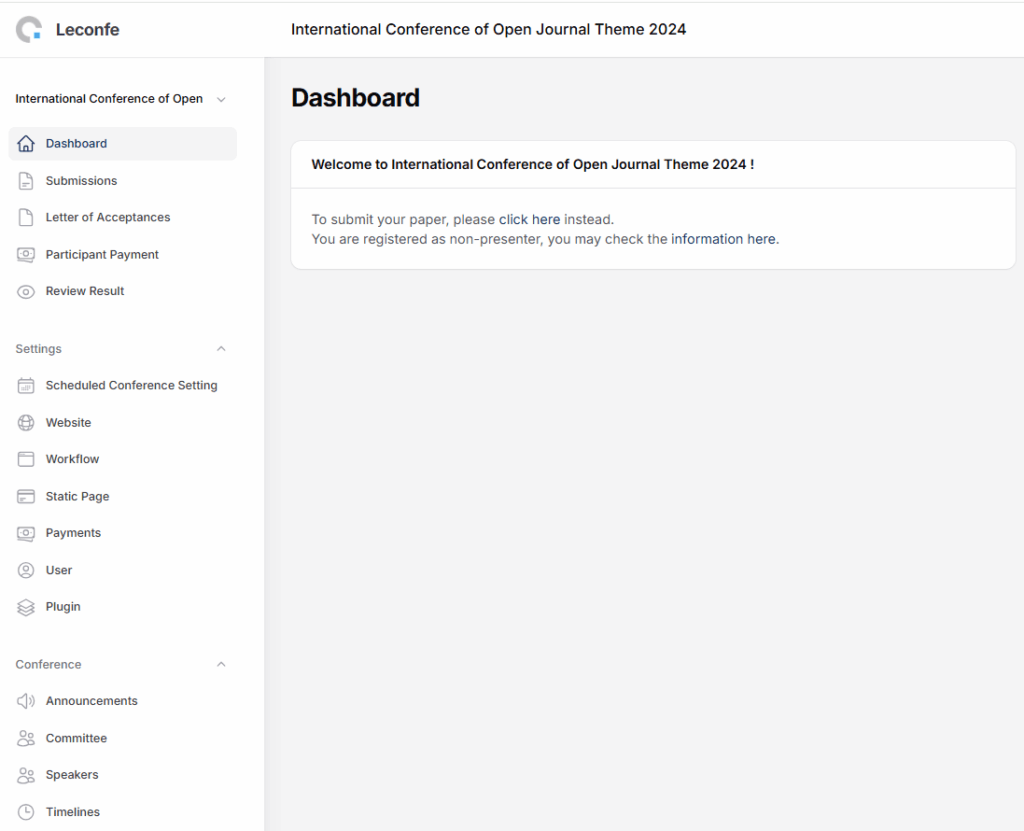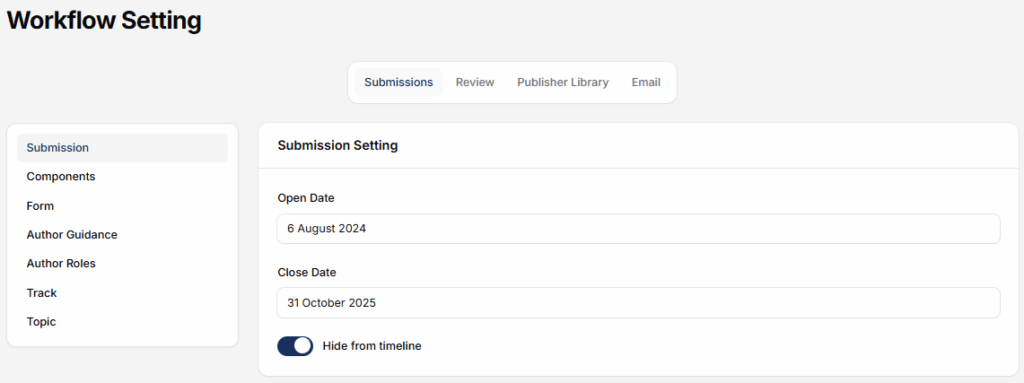Dashboard

Dashboard Overview
The Dashboard serves as the main control panel for managing and navigating all features within a conference instance in Leconfe. It provides a clear overview of essential functions for both authors and administrators, helping users access submission tools, manage content, and monitor conference progress efficiently.
Main Display
At the top of the dashboard, users will find a welcome message displaying the active conference title.
For example:
Welcome to International Conference of Open Journal Theme 2024!
From this section, authors can:
- Click the provided link to submit a new paper.
- Check their registration status (e.g., as a non-presenter) and access relevant information via the provided link.
Sidebar Navigation
The left sidebar offers structured access to all available features grouped by their functions:
Main Menu
- Dashboard – Displays the overview page and welcome message.
- Submissions – Manage paper submissions and monitor their status.
- Letter of Acceptances – View and download official acceptance letters.
- Participant Payment – Access participant payment information and confirmation status.
- Review Result – Check peer review outcomes and feedback.
Settings
- Scheduled Conference Setting – Configure details of scheduled conferences such as title, description, and date.
- Website – Manage the appearance and content of the conference website (logo, footer, featured conferences, etc.).
- Workflow – Define the submission and review process.
- Static Page – Create or edit static pages for additional information.
- Payments – Configure payment methods and transaction settings.
- User – Manage user accounts, roles, and permissions.
- Plugin – Enable or disable system plugins.
Conference Management
Timelines – Display important conference dates and deadlines.
Announcements – Post updates or important notices for participants.
Committee – Manage the list of conference committees.
Speakers – Add and manage conference speakers.
Submission

The Submission section in the conference management system provides a streamlined interface for managing and tracking all paper submissions. This section is organized into several tabs:
- My Queue: Displays submissions that have been specifically assigned to you for review or action.
- Unassigned: Shows submissions that have not yet been assigned to any reviewer or committee member.
- Active: Lists all currently active submissions that are in the process of review, revision, or awaiting final decisions.
- Presentation: Contains submissions that have been accepted and scheduled for presentation at the conference.
- Archived: Stores submissions that have been finalized and moved out of active status, either after acceptance or rejection, for future reference.

By clicking the “Settings” button, you can easily access advanced configuration options for the submission process. This allows you to customize various aspects such as paper components, author guidance, author roles, tracks, and more, ensuring that the submission process aligns with the specific requirements of your conference.

To manage the opening and closing dates for paper submissions, you can configure these settings in the “Workflow Setting” menu.

Scheduled Conference Setting
Masthead
The configuration you make in this menu will have an impact as shown on the following page.

The Scheduled Conference menu provides an organized overview of upcoming conferences, displaying key details such as the conference title, start and end dates, description, and location. It also includes columns for a conference summary, information about the editorial team, and an “About the Scheduled Conference” section.
Contact

The Contact menu allows conference organizers to provide their contact details for participants and stakeholders. This form typically includes fields for the organizer’s name, email, phone number, and any additional contact information. It ensures that participants can easily reach out to the organizers for inquiries, support, or additional information regarding the conference
Website
Appereance
Theme

This menu allows you to customize the color scheme of your conference, ensuring it aligns with your branding. If you have specific customizations for your conference page, you can create them using a CSS file and upload it through the “Custom Stylesheet” menu.
Setup

In this menu, you can customize the logo and thumbnail for your conference. Additionally, you can set the footer information for your conference pages.
Sidebar

The Sidebar menu allows you to manage the display of various elements such as committees, agenda, topics, or custom blocks created in the plugin menu. All these data will appear in this sidebar, and if you want them to be visible on the front page, simply check the items you want to display. Additionally, you can organize the order of these items directly within this menu for a well-structured sidebar layout.
Supports

The Supports menu provides tools for managing conference sponsorships and partnerships. Within this menu, you can define various Sponsorship Levels, Add Sponsor, and Add Partner details. These options allow you to organize and showcase sponsors and partners based on their contribution levels, helping to streamline sponsor management and visibility for the conference.
Sponsorship Levels

This section allows you to define different levels of sponsorship (e.g., Platinum, Gold, Silver) based on the sponsor’s contribution.
Sponsors

This option enables you to add detailed information about each sponsor, including their name, logo, and level of sponsorship.
Partners

This section is for adding key partners of the conference, distinct from sponsors. You can input partner details such as logos.
Setup
Navigation Menu

The Navigation Menu allows you to configure the main menu on your conference page, enabling you to add, remove, and organize menu items. There are two configuration options within this menu:
Primary Navigation Menu:

This is the main menu displayed prominently on the conference site. It typically includes key sections like home, agenda, submissions, and announcements, providing easy access for all users.
User Navigation Menu:

This menu is user-specific, offering options related to user accounts, such as login, profile, and register.
To remove or add child items within each navigation menu, simply hover your pointer over the top-right corner of any navigation item.

Privacy Statement

In this menu you can add information about how user data is collected, stored, and used during the conference. It outlines the platform’s privacy policies, ensuring transparency and compliance with data protection regulations.
Setup

The Timezone Configuration menu allows you to set the default timezone for your conference. This ensures that all event schedules, submission deadlines, and notifications are accurately displayed based on the chosen time zone.
Workflow
Submissions
Components

By default, Leconfe provides several commonly used paper components. However, if adjustments are needed or you wish to add specific components, you can do so within this menu, allowing for more tailored configurations to suit your conference needs.
Author Guidance

The Author Guidance menu comprises several key sections, including Author Guidelines, Before You Begin, and Submission Checklist. Each of these components can be customized to align with the specific requirements and objectives of your conference.
Author Roles

Within the Author Roles menu, you have the flexibility to customize the roles according to your conference’s.
Note:
Ensure that any changes to author roles align with your conference’s policies and academic standards. It is advisable to review and update these roles before opening submissions to maintain consistency throughout the conference proceedings.
Track

Tracks in conferences serve as an organizational framework to categorize and structure content effectively. They allow for thematic grouping of presentations or papers.
Topic

If your conference covers a variety of topics, you have the option to apply a categorization system through this menu feature. Please create and adjust the topic to the scope of your conference.
Reviewer
Setup
This tab allows you to configure your conference review process.

The Setup Review feature allows you to configure review process settings for your conference. It includes two key options:
Default Response Deadline: Sets the standard deadline by which reviewers should submit their feedback on submitted papers.
Default Completion Deadline: Defines the overall deadline for completing the review process, including final decisions and recommendations.
Reviewer Guidance

Review Guidelines: Provides detailed instructions and criteria for reviewers to follow when evaluating submissions.
Competing Interests: Requires reviewers to disclose any potential conflicts of interest that could influence their evaluation of the submissions.
Email Templates

The Email Templates feature allows you to create and manage predefined email messages for various conference-related communications. You can customize templates for notifications, reminders, and updates, ensuring consistent and professional messaging to participants, reviewers, and other stakeholders.
Layout Templates

The Layout Templates feature enables you to design and customize the visual layout of your conference website. By selecting and modifying different templates, you can create with your conference branding and requirements.
Plugin
All of the plugins listed here are available in your conference. Check the Enable link to use them.

The Plugin menu in the conference platform allows you to manage and enhance the functionality of your conference site. If you want to upload custom plugins that are not available in the plugin gallery, you can use the Upload Plugin feature, which supports uploading plugins in the .tar.gz format.
Static Page

The Static Page feature in the conference platform allows you to create and manage custom web pages with static content, such as additional informational pages.
Payment

The Payments menu in Leconfe allows administrators to manage all payment-related configurations for both submission fees and participant registration fees.
This feature ensures that payment processes are handled seamlessly and transparently throughout the conference workflow.
For detailed information on configuring payment options, fees, and available methods, please refer to the full documentation:
🔗 Configuring Payment Settings in Leconfe v1.3.0
User

The Users feature allows you to manage user accounts within the conference platform. You can add new users, edit existing user information, delete users, and set or modify user access rights.
Announcement

The Announcement feature in the conference platform allows you to broadcast important updates and information to all participants. You can create and post announcements about schedule changes, event details, or other relevant news, ensuring that attendees stay informed throughout the conference.
Commitee
Committees

The Committees feature allows you to manage conference committees. It includes two key options: New Committee, which lets you create and add a new committee.
Committee Positions

Committee Position, where you can define and assign specific roles for committee members, helping to structure and organize the leadership team for the event.
Speaker
Speaker

The Speaker feature allows you to manage and add details for conference speakers, including their profiles, biographies, and session assignments.
Speaker Roles

The Speaker Roles feature lets you define specific roles for each speaker, such as keynote speaker, panelist, or session moderator.
Timelines

The Timeline feature allows you to manage important conference schedules. In this menu, you’ll find buttons like Session and New Timeline, which enable you to create, organize, and adjust sessions or add new timelines.

In the New Timeline creation form, you’ll find several options, such as Require Attendance and Type. Enabling Require Attendance means that participants must check in to attend the event you’ve created. Under Type, you’ll see various options for categorizing the event, as shown in the image below.




